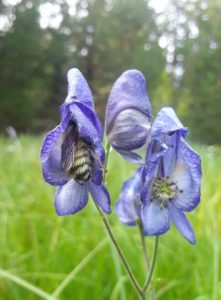Bumble Bee Field Trip
June 22, 2019 | with Rich Hatfield

OHA’s bumble bee field trip on June 22, 2019 provided community members with an opportunity to learn about the bumble bee species in our area, their importance to our ecosystem, as well as ways we can help conserve them. In an effort to learn more about bumble bees to improve evidence-based bumble bee conservation guidance, the Xerces Society for Invertebrate Conservation, in partnership with the Washington Department of Fish and Wildlife, Idaho Department of Fish and Game, and the Oregon Bee Project, has launched the Pacific Northwest Bumble Bee Atlas. On a trip around the Okanogan Highlands, Rich Hatfield, Xerces Society conservation biologist, shared information about the Atlas Project, how to participate, and the value that the project will have to our area, both locally, and more regionally. The group conducted a point survey at Lost Lake to help determine the number of bumble bee species living there, along with a rapid habitat survey. More about the survey: www.pnwbumblebeeatlas.org/point-surveys.html
This field trip connected the community with our native bumble bees and other pollinators and the contributions they make. The event provided inspiration and a user-friendly method of getting involved in citizen science to make positive strides toward effective conservation.
About Rich Hatfield
Rich Hatfield is a Senior Conservation Biologist with the Xerces Society for Invertebrate Conservation. The Xerces Society, founded in 1971, is a non-profit environmental organization that focuses on the conservation of wildlife, through the protection of invertebrates and their habitat. Rich is a leader in bumble bee conservation, with a demonstrated history of effectively using science, advocacy, and citizen science to protect wildlife and their habitat. Rich has a Master’s degree in Conservation Biology from San Francisco State University. He has special knowledge of our region’s species and issues due to his ongoing involvement in the Sinlahekin Wildlife Area in Okanogan County.
This event was provided in partnership with Humanities Washington, with community member financial support.
Bumble bees we observed during the field trip:
Bombus appositus ~ White shouldered bumble bee – 1 site
Bombus bifarius ~ Two form bumble bee – 3 sites
Bombus centralis ~ Central bumble bee – 2 sites
Bombus fervidus ~ Yellow bumble bee – 1 site
Bombus flavidus ~ Fernald’s cuckoo bumble bee – 1 site
Bombus flavifrons ~ Yellow head bumble bee – 1 site
Bombus griseocollis ~ Brown belted bumble bee – 2 sites
Bombus huntii ~ Hunts bumble bee – 1 site
Bombus melanopygus ~ Black tailed bumble bee – 1 site
Bombus mixtus ~ Fuzzy horned bumble bee – 3 sites
Bombus occidentalis ~ Western bumble bee – 1 site
Bombus rufocinctus ~ Red belted bumble bee – 2 sites
bees, education, events, field trip, highland wonders, insects